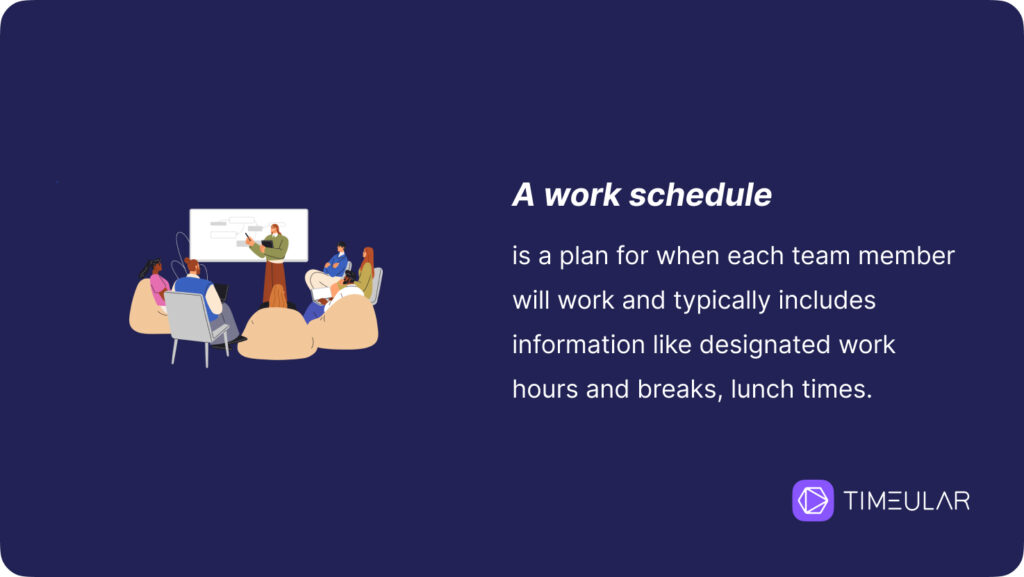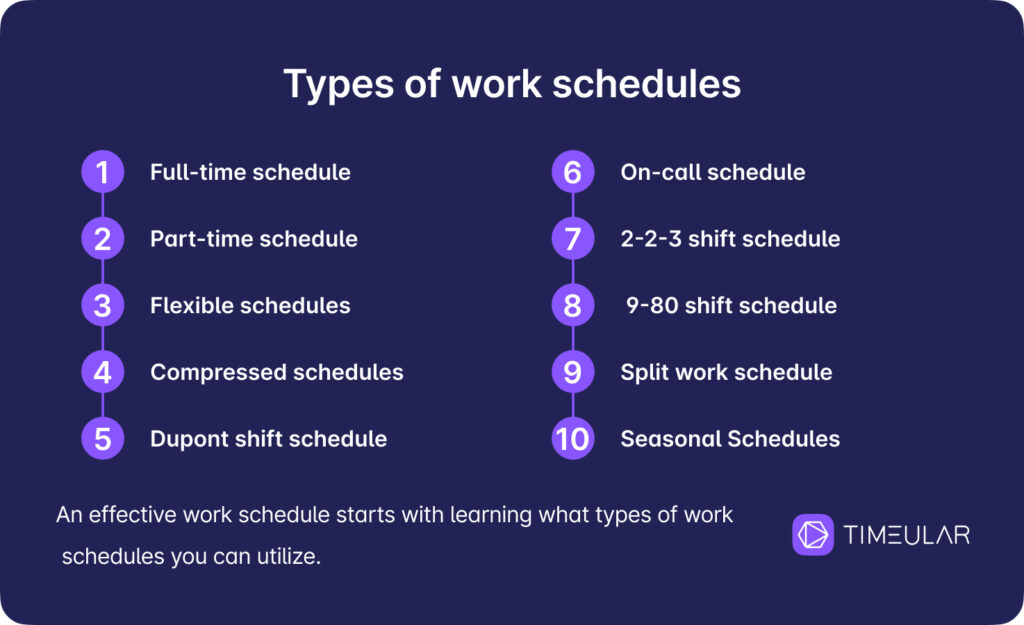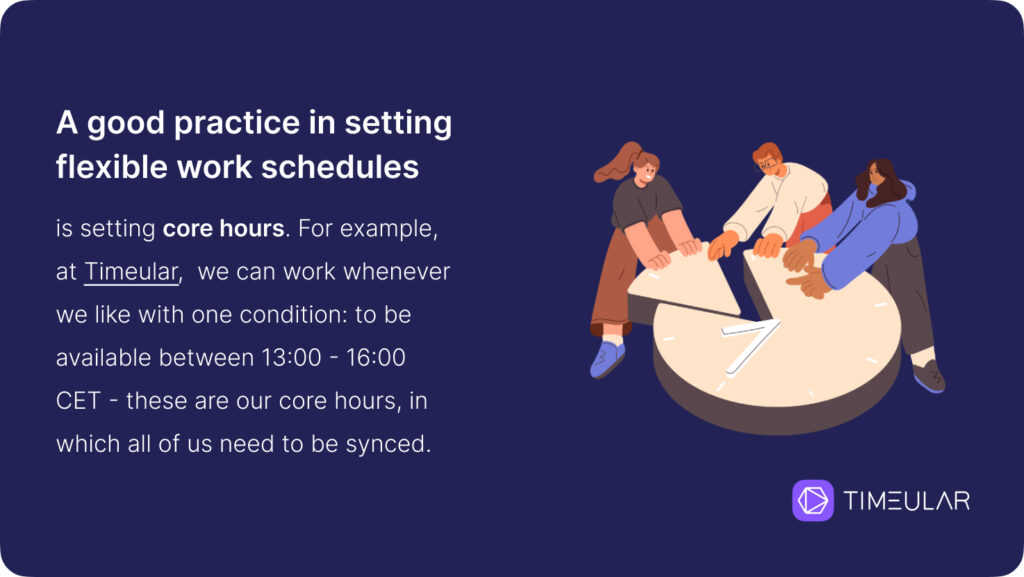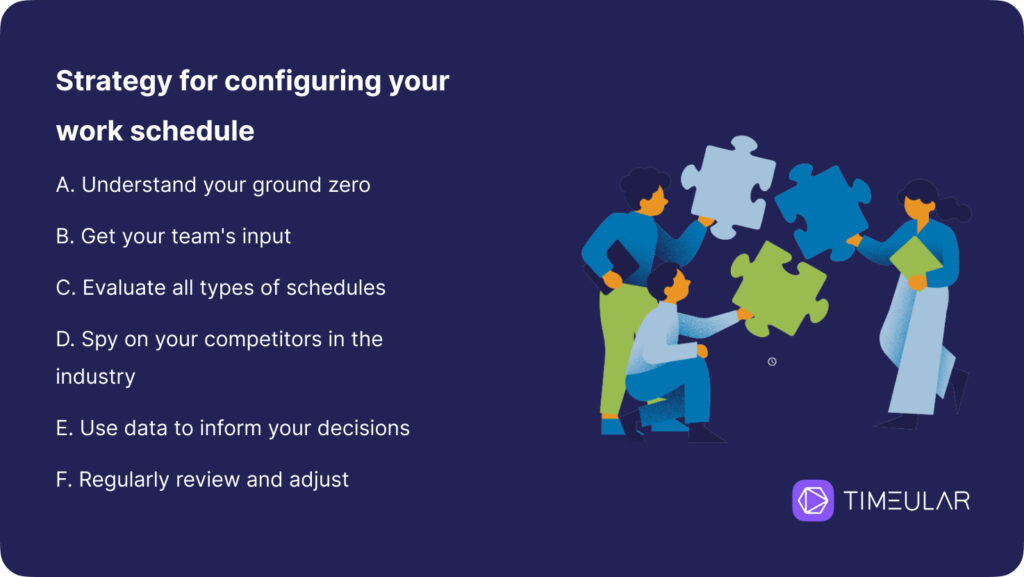Work Schedule: Types, Tips, and Strategy to Create It
Happy clients, smooth operations, high productivity, and profitability, along with employee well-being. It’s a no-brainer that you’re looking to achieve all these goals in your business, and a work schedule is needed for a good reason. Done well, it works wonders.
However, creating work schedules that satisfy everyone is challenging. You have to use a seemingly magic of ingredients to succeed. In this article, I’ll unpack the types of work schedules and how to create them with employee appeal and business efficiency.

Make sure your time is well spent by tracking and managing it with automatic time-tracking apps.
TLDR
Setting employee work schedules in a balanced way is a win-win: your employees will be happier, more involved in their jobs, and more productive, and your business gets its much-needed currency to function: profitability. Here’s what you’ll find in this article:
Understand what a work schedule is and why it matters
Discover what types of work schedules you can adapt to your business
Learn strategies and tips that help you configure your work schedule
What is a work schedule?
Work schedules have been created to ensure that your team matches the demands of your business. In other words, it’s important to ensure that your team is in the right place at the right time to keep things running smoothly.
A work schedule is a plan for when each team member will work and typically includes information like designated work hours, breaks, lunch times, and other details related to work activities. It’s like a map that shows who is working when they’re working and what they’re supposed to be doing during their shift.
Please note: There are more work habits that lead to a successful business. Explore them all!

Just like search engines use algorithms to understand what users want, businesses use work schedules to align their operations with both employee needs and business goals. When you create a work schedule, you’re not just filling in time slots. You’re figuring out how to maximize productivity, accommodate employee preferences, and ensure your business meets its operational requirements.
So, really, creating work schedules has everything to do with understanding and satisfying humans – that’s something that should put things into perspective.
Remember that you need to also know how to say no at work sometimes.
Types of work schedules
Having an effective work schedule starts with understanding what types of work schedules there are. If this is not sufficient, I’m convinced you can create your own, but reinventing the wheel can be time-consuming. A working schedule is an ever-changing type of process. It evolved with your business, and you need to always keep tabs open to your employees’ needs and the business’s growth, too.
Did you know that on a 40-hour work schedule, we spend 71.5% of our time in a year at work? I expanded this topic more in the article on how many work days there are in a year.
Let me introduce you to 10 types of work schedules:

1. Full-time schedule
The pattern of 8-hour workdays, Monday through Friday, is the most common type of work schedule met – often identified as a fixed work schedule. Typically, this type of work schedule includes 40 hours of work per week, with regular working hours from 9 AM to 5 PM, but it depends on the industry.
What’s best about fixed schedules is the fact that both the employees have the predictability of a set schedule, and your business has dependable availability during key business hours.
2. Part-time schedule
Part-time employees might prefer an alternate work schedule, as this can help them balance their personal lives and family commitments. On the business side, for your organization, an optimal work schedule can involve catering to peak times without committing to a 40-hour week.
With such flexible work schedules, businesses can manage labor costs while still covering critical operational needs. This type of work schedule varies from 20 to 30-35 hours a week and can be a fixed schedule or not, and it’s at the discretion of the business or employee how many hours of work they should have.
BTW, part-time is often a go-to freelance schedule. Many of the freelancers I met mentioned that the more they increased their rates, the more they started a healthy work schedule.
- Check it out: Time tracking app for freelancers
3. Flexible schedules
The flexible work schedule, as it is called, has been growing in popularity over the last few years. And the question is, why would it not? As long as employees work and fulfill their commitments, they should be allowed to work whenever they’re productive.
However, something that’s helpful for a flex work schedule is setting core work hours.
Take our example: at Timeular, we can work whenever we like, but with one condition: to be available between 13:00 – 16:00 CET – these are our core hours, in which all of us need to be synced in a day, or have calls, and the remaining hours are at our discretion.

4. Compressed schedules
Imagine getting a full week’s work done in fewer days. The dream!
That’s what a compressed work schedule is: working longer hours over four days instead of five. This type of work schedule is also called the 4-10 shift schedule. This compressed schedule keeps an employee’s work-life balance and the business’s operations predictable, as the hours worked are fixed.
5. Dupont shift schedule
The Dupont schedule is a more complex type of program that functions on the model of a rotating shift work schedule. Frequently met in businesses or industries that operate around the clock, like healthcare, police, food service, and manufacturing, as they need coverage 24/7.
So, the Dupont shift schedule is formed from an 8-week cycle with 12-hour shifts. It’s important to note that employees generally get extended breaks in such a shift to maintain their productivity and reduce burnout rates.
Rotating shift work schedules involve working for 4 days in a row, followed by 3 days off, then 3 days on, 1 day off, then 3 days on, and 3 days off. This cycle ensures employees get rest however, there’s no control over having early or late shifts.
6. On-call schedule
The on-call schedule often applies to healthcare, emergency services, or online stores that need to be up and running 24/7. This type of irregular work schedule can impede having a good work-life balance, as anyone who has on-call night shifts or has an on-call day needs to be available to go to work on short notice.
So, if your business requires such immediate response to urgent needs, this unpredictable work schedule might suit you.
7. 2-2-3 shift schedule
Another alternative schedule solution involved working for 12 hours in a cycle of 2 days on, 2 days off, and 3 days on, repeating every two weeks. This schedule helps with keeping a good balance between work and personal life, but also allows for continuous business coverage. This work schedule is also called the Panama schedule.
- Read more about the 2 2 3 schedule.
8. 9-80 shift schedule
This innovative schedule allows employees to work 80 hours over nine days instead of the usual ten, which results in a long weekend every other week. It’s quite a creative solution for employees looking for a more flexible work schedule rather than a standard schedule.
9. Split work schedule
In a split shift, employees work two separate shifts in a single day, often with a larger break in between. It is often used in hospitality and customer service, where the highest demands are during breakfast and dinner hours, but with a decrease in between.
The employees’ work schedules in split shifts are typically from 7 AM to 11 AM and then again from 4 PM to 8 PM.
10. Seasonal Schedules
Seasonal schedules are suitable for businesses that experience fluctuations in demand throughout the year, such as retail stores during the holiday season or resorts during peak tourist months. With this type of schedule, you can hire additional staff temporarily to handle increased workloads.
For example, a ski resort might hire more staff during the winter months and reduce staffing during the summer. Otherwise, the ski resort might have an overhead of a full-time workforce year-round, which affects financial sustainability.

Strategy and tips to configure your work schedule
Configuring the best work schedule for your team, your specific industry, and your business requires understanding some important dynamics. Keep in mind the following:
A. Understand your ground zero
Start with understanding your business’s unique needs with two clear objectives in mind: Assess operations requirements and identify your peak hours.
To get to an answer, ask yourself the following questions:
Are we currently fulfilling demand with our current supply?
When do you have the highest customer traffic on your online store?
When is the time that you get the most service requests?
What does your sales data transmit?
Is your business in an operationally intense industry that needs 24/7 coverage?
Do you have seasonal demands, such as during summer, winter, or only during Black Friday?
B. Get your team’s input
Enforcing a new work schedule on your employees can backfire on the business’s productivity. So, it’s best to discuss employees’ work scheduling preferences. You don’t have to discuss 1-1 with everyone; a survey would do the job. Ask questions like:
Are you comfortable working early mornings, late evenings, or overnight shifts?
Are there any days or times you are consistently unavailable to work?
Are there any health or personal reasons that impact your ability to work certain hours?
How satisfied are you with your current work schedule?
Do you have any suggestions for improving our current scheduling practices?
How do you feel about the possibility of working on-call shifts?
Did you know that giving feedback is one of the best ways to keep your employees motivated?

Make sure your time is well spent by tracking and managing it with automatic time-tracking apps.
C. Evaluate all types of schedules
There is no one-size-fits-all approach or a single ideal work schedule. Evaluate the various types of work schedules I introduced you to and consider how these align with your business needs and employee preferences.
D. Spy on your competitors in the industry
If your competitors seem to be thriving in their business, then there’s no wrong in trying to understand how they approach work scheduling. If you’re learning that another successful business from your industry is hiring employees for a few hours ( for example, part-time) while you’re hiring full-time, then it means that they have a secret you need to apply for, too.

E. Use data to inform your decisions
Once you’ve applied some scheduling practices, you need to identify what works and what doesn’t. Look for patterns that indicate effective scheduling and its surfacing metrics important for productivity and employee well-being. You need to
-> Monitor performance metrics that matter: Track metrics such as productivity, attendance, overtime hours, and employee satisfaction to gauge the effectiveness of the applied schedules.
Use automatic time-tracking software to surface insights like overtime hours, when your team is most productive, and when they’re not, and then create work schedules based on the time-tracking software data.
Use employee scheduling software to check employee availability and inform your scheduling process with more ease. Such an employee scheduling app is Deputy.
F. Regularly review and adjust
Creating the ideal work schedule is an ongoing process. Continuously monitor its effectiveness and be ready to make adjustments. Just as you would revisit your content strategy based on performance data, regularly review your scheduling practices.
Schedule periodic team meetings for check-ins with your team and understand how the schedule works for them.
Stay flexible and open to making changes reflected in your team’s feedback or your evolving business needs.
You might be interested in How to measure team effectiveness and How to deal with employees who complain about the workload.
Why is work scheduling important?
Work scheduling is pivotal for keeping a happy, efficient, and productive workplace. It’s not just about deciding who works when—it’s about creating a system that benefits both your business and your employees. Here is why work scheduling is important and should be prioritized:
Optimizes productivity: Whenever employees are given a specific timeframe and structured framework to finalize some work, then they will strive to get there.
Enhances compliance: Labor laws in connection to work hours, the overtime schedule, and breaks are quite strict, so with a predefined work schedule, you’re covered from legal issues.
Guaranteed staff coverage: This is not only for businesses that function around the clock but also for the ones that may need on-call work. With a precise set schedule, your demand needs are fulfilled by your workforce planning.
Increased well-being at work: Employees have better predictability in handling their personal lives and their well-being, and work-life balance is impacted in a good way, too.
Enhanced accountability: When you’re clearly defining a work schedule, employees understand that their responsibilities need to be fulfilled in those set hours – no more, no less. So, in this way, you’re encouraging consistency, accountability as well as engagement.

Make sure you plan the work schedule based on data. An automatic time-tracking surfaces your time spending habits, as well as where productivity is sinking.
Create human-centric work schedules
Sometimes, we toss around the purpose of an employee schedule into a business schedule. But really, you can do both. You can create and manage work schedules for employees and for your business, too. With a few key strategies in place and the right work schedule for your unique case, you can balance your business demands with a happy team.
